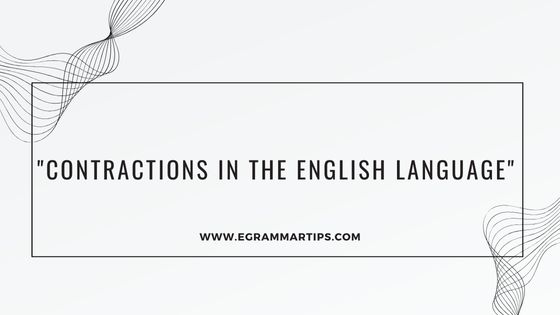
Contractions are a crucial part of English communication, especially in spoken and informal writing. They make your speech sound more natural and help convey ideas quickly and efficiently. In this lesson, we will cover what contractions are, how they are formed, common contractions, and when to use or avoid them.
Table of Contents
ToggleWhat Are Contractions?
A contraction is a shortened form of one or more words created by omitting certain letters and sounds. In place of the omitted letters, an apostrophe (‘) is used. Contractions are widely used in casual speech and writing, making the language faster and more fluid.
Examples:
- I am becomes I’m
- You are becomes You’re
- Did not becomes Didn’t
How Contractions Are Formed
Contractions are typically formed by combining a pronoun or noun with an auxiliary (helping) verb or the word not. The apostrophe replaces the omitted letters. Here’s how contractions are usually formed:
1. Pronoun + Verb Contractions
These contractions combine a subject (pronoun) with auxiliary verbs like am, is, are, will, have, or had. They are common in both spoken and written English.
2. Verb + Not Contractions
These contractions combine auxiliary verbs with the negative word not. Instead of saying the full phrase, contractions are often used to shorten the expression and make it more conversational.
3. Will and Would Contractions
Will and would are often contracted with pronouns to sound more informal and efficient.
Common Contractions
Here is a list of some of the most commonly used contractions in English:
Positive Contractions
These are used to shorten positive statements, where the subject is combined with a helping verb or will.
- I’m = I am
- We’ve = We have
- He’s = He is / He has
- You’ll = You will
- They’ve = They have
- It’s = It is / It has
Negative Contractions
These are used to express negation by combining a verb with not.
- Isn’t = Is not
- Aren’t = Are not
- Didn’t = Did not
- Can’t = Cannot
- Won’t = Will not
- Doesn’t = Does not
- Haven’t = Have not
Modal Verbs and Contractions
Modal verbs like can, could, should, would, and might also form contractions with not.
- Can’t = Cannot
- Couldn’t = Could not
- Shouldn’t = Should not
- Wouldn’t = Would not
- Mightn’t = Might not
Double Contractions
In informal speech, native speakers sometimes use double contractions, which combine two contractions. While these are rarely used in formal writing, you may hear them in everyday conversation.
- I’d’ve = I would have
- He’d’ve = He would have
- You’ll’ve = You will have
Contractions in Formal vs. Informal Writing
When to Use Contractions
Informal Writing: Contractions are commonly used in emails, messages, casual essays, and blog posts. They create a conversational tone.
Example: She’s going to the party tomorrow.
Dialogue in Fiction: Writers use contractions to make dialogue more natural and realistic.
Example: “I can’t believe you’re here!” she said excitedly.
When to Avoid Contractions
Formal Writing: Avoid contractions in academic papers, business proposals, and legal documents. Formal writing favors the complete form for clarity and professionalism
Example: She is going to the meeting tomorrow.
Official Communications: Reports, formal letters, or official documents often require the full form of words without contractions.
Example: It is important to complete the task on time.
Pronunciation of Contractions
To speak fluently, it’s important to master the pronunciation of contractions. Native speakers use contractions naturally, and they often blend sounds together. Practice these sounds to improve both your fluency and comprehension.
“I’m” is pronounced as a short version of “I am,” merging the words to sound like /aim/.
“He’s” and “He has” are both pronounced as /hiz/, so context is key to understanding the meaning.
“They’re”, “There”, and “Their” are homophones, meaning they sound the same (/ðɛr/) but have different meanings.
Exercise: Practice Saying Contractions
Try saying the following sentences out loud, paying attention to how contractions sound in each one.
I’m going to the store.You’ll be fine.
She’s already left.
They’re coming over for dinner.
Common Mistakes with Contractions
1. Confusing “It’s” and “Its
”It’s = It is / It has
Example: It’s raining outside.
Its = Possessive form of it
Example: The dog wagged its tail.
2. Confusing “They’re”, “Their”, and “There”
They’re = They are
Example: They’re coming to the party.
Their = Possessive form of they
Example: That’s their car.
There = Refers to a place
Example: The keys are over there.
3. Double Negatives with Contractions
In English, using a double negative (such as “didn’t” + “nothing”) is grammatically incorrect and creates confusion. In standard English, we use just one negative word.
Incorrect: I didn’t do nothing.
Correct: I didn’t do anything.
Conclusion
Contractions are an essential part of the English language that allow for faster, more natural communication. They help speakers sound more fluent and are used widely in informal contexts. By mastering contractions, you can make your speech and writing sound more natural, and you’ll be better prepared for everyday conversations